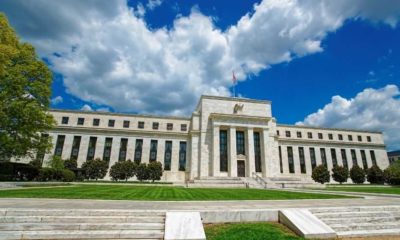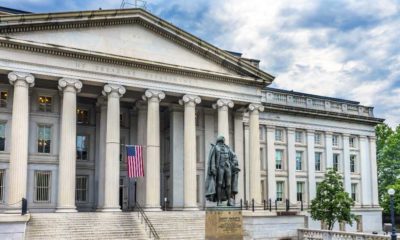bank
Do Low Treasury Yields Keep Stocks From Thriving?

Given that it’s normal for Treasury yields to go down as Treasury pricing goes up, one would think that low Treasury yields would be a good indication of a strong Treasury market.
They should indicate that Treasuries—and therefore at least that corner of the stock market—are thriving.
However, as recent evidence shows, this may simply not be the case.
The Equities Portion Of The Stock Market Did Do Better In April
In the third week of April, the S&P 500 managed to work its way up to -0.85%.

While the Dow Jones Industrial Average climbed to -1.05%.

Both were in the neighborhood of 1% from their record highs.
This was, indisputably, a very positive sign for the equities market.
[ms_divider style=”normal” align=”left” width=”100%” margin_top=”30″ margin_bottom=”30″ border_size=”5″ border_color=”#f2f2f2″ icon=”” class=”” id=””][/ms_divider]
[ms_featurebox style=”4″ title_font_size=”18″ title_color=”#2b2b2b” icon_circle=”no” icon_size=”46″ title=”Recommended Link” icon=”” alignment=”left” icon_animation_type=”” icon_color=”” icon_background_color=”” icon_border_color=”” icon_border_width=”0″ flip_icon=”none” spinning_icon=”no” icon_image=”” icon_image_width=”0″ icon_image_height=”” link_url=”https://offers.thecapitalist.com/p/warrenbuffet/index” link_target=”_blank” link_text=”Click Here To Find Out What It Said…” link_color=”#4885bf” content_color=”” content_box_background_color=”” class=”” id=””]Warren Buffett Just Told His Heirs What He Wants them To Do With His Fortune When He Dies. [/ms_featurebox]
[ms_divider style=”normal” align=”left” width=”100%” margin_top=”30″ margin_bottom=”30″ border_size=”5″ border_color=”#f2f2f2″ icon=”” class=”” id=””][/ms_divider]
Treasuries, While Strong, Are Not Gaining At The Same Rates As Stocks Are
Treasuries are still a desired commodity, meaning that their yields have remained almost as low as their lowest dip on Feb 11th, gaining only 50 basis points in the interim.
This is in direct contrast to the S&P 500, which has gained 217 points since Feb 11th.

Clearly, treasuries are just not keeping pace with equity gains.
With stocks doing poorly at the beginning of the year, investors were freaked and fled to the safety of Treasuries.
But when the market began to bounce back in February, the U.S. Ten Year Treasury Note yield did not follow suit.
In fact, it has gone through several spikes and valleys heading in a generally downward direction and landed well south of the S&P 500.
This Does Not Mean That The Low Yields Are Entirely A Bad Thing.
Yes, low yields on Treasuries can be an indicator of a spooked or depressed market.
However, equity is currently outperforming Treasury yields, and just because Treasury yields are now being outperformed does not necessarily make them a bad investment.
Yields are still low, meaning that the government can borrow money at a very low-interest rate.
The flip-side of this is, of course, that the government can borrow money at a very low interest rate, and there is concern that it may spend the borrowed money irresponsibly.
Experts At The Federal Reserve Bank Of St Louis Point Out Some Benefits To Low Interest Rates In General
- Lower interest rates makes borrowing easier. By lowering the cost of borrowing, low yields encourage companies to invest in capital goods. They also encourage individual consumers to buy items that often require loans, such as automobiles and permanent housing.
- Banks can lend more easily.
- Finally, asset prices can take a boost. With more access to money, people find themselves spending money on goods and services, or assets like houses or corporate equities. This increased demand, especially for the latter, leads to higher prices in these markets.
So, Low Yields Mean A Stronger Equity Market, Correct?
If Treasury bonds pull in only a very small rate of interest return, it stands to reason that investors will go for equity stocks instead.
J.P. Morgan Begs To Differ, Saying That Low Yields Are Keeping The Market Down
It claims that the same worries that pushed people to invest in treasuries to begin with are preventing them from branching back out into equities.
It also cites central bank policies, along with slow market growth to begin with, as having led to the low yields and accuses them of sustaining lower yields indefinitely.
J.P. Morgan’s Proposed Solution
Bite the bullet and very cautiously begin investing in the historically safer equities—they cite utilities, telecom, and real estate as good examples. Without a certain amount of equity purchasing, low interest rates will yield no market growth of consequence.
They also recommend dropping cyclical stocks.
The reason for this is the general trend of consistently low Treasury yields meaning slow market growth which will hurt these cyclicals and, by extension, those who invest in them.
In short, be a little brave and branch away from treasuries for a time.
Brad Friedlander Of Angel Oak Capital Advisors Estimates That The Situation Cannot Remain As It Currently Is.
He believes that both sectors are probably going to correct themselves.
He suggests that equity will drop somewhat, and yields will grow somewhat leading to a compromise position for both.
Unfortunately, that means that neither will yield spectacular results for their investors in the short term.
So What Does This Mean For The Average Investor?
It would appear that the overall market requires a balance of investments in Treasury bonds and equities.
While Treasury bonds are very safe, they are also giving back little return on investment with such low yields at the moment.
While equities are riskier, a certain amount of equity investment is also required for a healthy market.
Good luck and skill with equity investment may yield higher gains than Treasury bonds.
While no one is under any obligation to take one for the team and go into equity, pulling out of Treasury bonds for the time being would raise yields and—if J. P. Morgan is right—improve economic growth overall.















